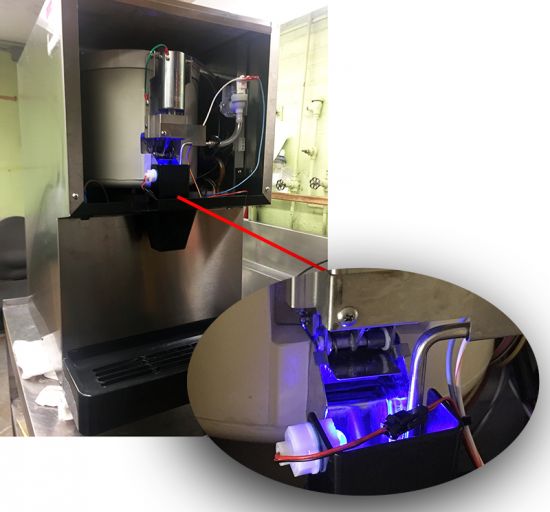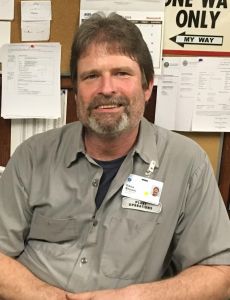April 2, 2019
April 2, 2019

Like many light bulbs that pop suddenly into existence above the heads of imaginative thinkers, the idea for installing UV sanitizers in the ice machines at Cooley Dickinson Hospital was driven by necessity as well as the desire to keep patients and staff safe.
Rob Westort from the Facilities Dept. was opening and bleaching the black funnels on over 20 ice machines, every two weeks, in order to avoid a build-up of a black substance inside the machine that had become noticeable to many staff who work on the hospital units.
“Staff would sometimes wonder if there were problems with the ice machines,” recalls Manager of Infection Prevention Linda Riley, RN. “The ice machines were fine. Rob was being proactive. This is typical of our staff. They go above and beyond for our patients and employees every day!”
While the bleach was effective enough and killed the common mold found in the air, the process Rob had in place was time-consuming and labor-inefficient.
Eventually, a light bulb – in this case an ultraviolet light bulb – went off over the head of Lead HVAC Technician Dana Benoni, who knew there had to be an easier way.
“Water [including water that feeds the ice machines] in all patient care areas is tested annually and, while drinking water is not sterile, we do not have a problem with disease-producing organisms in our water,” says Linda, “but the mold wasn’t coming from the water – it was probably coming from the air.”
Some of the air ducts in the hospital already contain UV lights to kill germs and mold spores, giving us excellent overall air quality. However, hospital air mixes with outside air and, just like water, air is not sterile and contains mold spores that will grow in a wet environment.
Dana says that these spores were the source of the black substance inside the machines, and over a few months he devised a simple UV light that he was able to retrofit to the machines’ interiors, adjacent to the funnels.

In order to test the effect of his devices, Dana cultured funnels with and without the UV light. There was no growth after a month on the funnel with the UV light. The funnel without the UV light had mold growing on the culture plate at two weeks, however there was no visible mold on the funnel, so it appeared clean.
“This is a great idea that will make our patients safer, as well as save time and cost for the Facilities Department,” says Linda of Dana’s built-on-the-fly sanitizer. “Because it has the potential to impact many lives, I shared the information about Dana’s invention and the culture results with the Centers for Disease Control and Prevention and Mass. Department of Public Health.”
Encouraged as he has been with the results of his experiment, Dana says he can see other potential uses of the UV sanitizer, such as in water coolers or even water fountains.
“I’m obviously not reinventing the wheel here,” Dana says with a modest but genuinely charged attitude of enthusiastic ingenuity, “and most of this stuff isn’t terribly harmful. I guess it’s a measure that you’d probably call ‘proactive.'”

